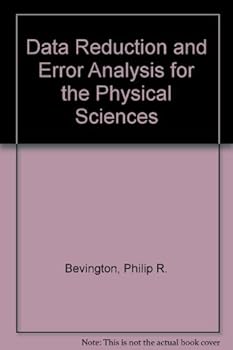Data Reduction and Error Analysis for the Physical Science
Select Format
Select Condition 
Book Overview
The purpose of this book is to provide an introduction to the concepts of statistical analysis of data for students at the undergraduate and graduate level, and to provide tools for data reduction and error analysis commonly required in the physical sciences. The presentation is developed from a practical point of view, including enough derivation to justify the results, but emphasizing methods of handling data more than theory. The text provides a variety of numerical and graphical techniques. Computer programs that support these techniques will be available on an accompanying website in both Fortran and C++.
Format:Paperback
Language:English
ISBN:0070051356
ISBN13:9780070051355
Release Date:January 1969
Publisher:McGraw-Hill Book Company
Length:336 Pages
Weight:0.90 lbs.
Dimensions:8.0" x 5.3" x 0.6"
Customer Reviews
5 ratings
An Essential Book for Engineers and Scientists
Published by Thriftbooks.com User , 16 years ago
As a practicing engineer, this was one of 5 or 6 books that I found most essential throughout my career. Chapter 4 on Propagation of Errors was referred to very often in my work.
All new but just as good
Published by Thriftbooks.com User , 21 years ago
This book seems to have been completely rewritten by the new author, only keeping the outline of the original, and it's for the better. The writing is as careful as the original, and as economical, so you have to master the early chapters or the rest is hopeless, as things start off slowly but quickly become difficult. It begins by considering the error in a single measurement, and proceeds to estimating errors derived from curve fitting. A few nuclear decay experiments provide examples throughout, and the author insists on calculating many quantities manually, even though in practice it would never be done that way. Some background topics like matrix algebra appear in the appendix too.
Great Book
Published by Thriftbooks.com User , 23 years ago
I make measurements frequently and this book is great for providing the background to analyze your data.I took undergraduate level statistics and it never really gave the practical applied background in how to analyze data. It merely presented concepts and presumed you knew how and why to apply them. This book is very good at helping you to understand the how and why.I have read a number of other statistics book in search of the practical applied information provided in this book and did not find it in the other books.The writing is clear and consice. There is enough background provided for even those unexposed to statistics.I have not tried the software. Most of the formulas are easy to apply and can be implemented in simple programs or spreadsheets in very little time.In short, I recommend this book to anyone making measurements of any kind.
"Updated" classic, but still vintage '92
Published by Thriftbooks.com User , 27 years ago
Robinson's second edition continues the late Bevington's tradition of clear and concise writing, making this book a priceless reference for scientists. Robinson has added discussions of modern problems such as resolving closely-spaced peaks in a spectrum. The new version also adds chapters on Monte Carlo techniques and maximum-likelihood analysis, both powerful tools for data analysis made possible by better computers.The chapter structure has been modified considerably, so those who have grown comfortable with the first edition over the past decades may not be able to find things as easily. Other than that, most of the weaknesses are computer-related. Much has changed even since 1992.Robinson added an appendix on graphical presentation. This sounds promising but is a pretty trivial discussion of when to use linear or logarithmic axes and the advantages of a historgram. Might be useful for a very young student, but these days playing with such things is easy in any graphing program. Many of the computer code snippets have been removed. Most of them were only a few lines of code with lots of comment lines anyway. The codes that remain have been moved from the main text to a densely-packed appendix, which makes them more difficult to study while reading the text. The codes themselves have been updated from old FORTRAN to a structured language, but I would have preferred C or FORTRAN 90 over the chosen PASCAL. The latter may be useful for undergraduate students, but I've never seen a PASCAL compiler in a working physics lab. The included disk is a now-obsolete 5.25" floppy. I had to hunt for a machine that could read it and copy over to a 3.5" disc. The text claims repeatedly that the disc has both FORTRAN 77 and PASCAL routines on it, but my copy only has the PASCAL. In the end, it's the textual content that is important, and this book is a fantastic basic discussion of data analysis and statistics for students and a great reference for the practicing scientist.
A classic returned!
Published by Thriftbooks.com User , 28 years ago
Bevington's first edition of this book dates to the late 60's when Fortran ruled the world. I was crushed when I lost my copy in the mid 70's and am delighted to find he's written a modern updated edition!





